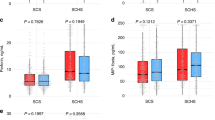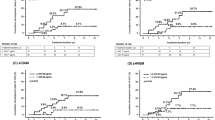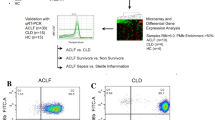Abstract
Suppressor of cytokine signaling (SOCS) 1 plays a crucial role in the immune response and might contribute to the prognoses of liver failure treated with glucocorticoid. We recruited 47 acute-on-chronic hepatitis B liver failure (ACHBLF) patients receiving glucocorticoid treatment and 30 healthy controls to determine the potential effects of glucocorticoid on the transcriptional level of SOCS1 in peripheral blood mononuclear cells. On the third and twenty-eighth days of glucocorticoid treatment, SOCS1 expression was negatively correlated with model for end-stage liver disease (MELD) score. Interleukin-6 (IL-6) and tumor-necrosis factor-α (TNF-α) levels were statistically lower, while the SOCS1 transcription level was higher in survivors than non-survivors both in pre- and post-treatment ACHBLF patients. The methylation rate of the SOCS1 promoter in ACHBLF patients was higher than in healthy control patients as determined by methylation-specific polymerase chain reaction. The mRNA level of SOCS1 in methylated promoters was significantly lower than from patients with unmethylated SOCS1 promoters. interferon (IFN)-γ-responsive and STAT1-dependent gene expression was higher in survivors and was dramatically decreased with rising expression of SOCS1 after glucocorticoid treatment. Mortality rates were significantly higher in methylated patients than for those without methylation at the end of a 90-day follow-up. Furthermore, we found that five in six surviving patients displayed demethylated SOCS1 on the twenty-eighth day after treatment, while that number was 3 in 10 in the non-survivors. These findings suggested that ACHBLF patients without SOCS1 methylation may have a favorable response to corticosteroid treatment.
This is a preview of subscription content, access via your institution
Access options
Subscribe to this journal
Receive 12 digital issues and online access to articles
$119.00 per year
only $9.92 per issue
Buy this article
- Purchase on Springer Link
- Instant access to full article PDF
Prices may be subject to local taxes which are calculated during checkout





Similar content being viewed by others
References
Sarin SK, Kumar A, Almeida JA, Chawla YK, Fan ST, Garg H et al. Acute-on-chronic liver failure: consensus recommendations of the Asian Pacific Association for the study of the liver (APASL). Hepatol Int 2009; 3: 269–282.
Finkenstedt A, Nachbaur K, Zoller H, Joannidis M, Pratschke J, Graziadei IW et al. Acute on chronic liver failure: excellent outcome after liver transplantation but high mortality on the wait list. Liver Transpl 2013; 19: 879–886.
Strebovsky J, Walker P, Dalpke AH . Suppressor of cytokine signaling proteins as regulators of innate immune signaling. Front Biosci 2012; 17: 1627–1639.
Babon JJ, Kershaw NJ, Murphy JM, Varghese LN, Laktyushin A, Young SN, et al. Suppression of cytokine signaling by SOCS3: characterization of the mode of inhibition and the basis of its specificity. Immunity 2012; 36: 239–250.
Linossi EM, Babon JJ, Hilton DJ, Nicholson SE . Suppression of cytokine signaling: the SOCS perspective. Cytokine Growth Factor Rev 2013; 24: 241–248.
Baetz A, Frey M, Heeg K, Dalpke AH . Suppressor of cytokine signaling (SOCS) proteins indirectly regulate Toll-like receptor signaling in innate immune cells. J Biol Chem 2004; 279: 54708–54715.
Shi J, Wei L . Regulation of JAK/STAT signalling by SOCS in the myocardium. Cardiovasc Res 2012; 96: 345–347.
Kubo M, Hanada T, Yoshimura A . Suppressors of cytokine signaling and immunity. Nat Immunol 2003; 4: 1169–1176.
He Y, Zhang W, Zhang R, Min W . SOCS1 inhibits tumor necrosis factor-induced activation of ASK1–JNK inflammatory signaling by mediating ASK1 degradation. J Biol Chem 2006; 281: 5559–5566.
Fenner JE, Starr R, Cornish AL, Zhang JG, Metcalf D, Schreiber RD et al. Suppressor of cytokine signaling 1 regulates the immune response to infection by a unique inhibition of type I interferon activity. Nat Immunol 2006; 7: 33–39.
Rosenblum JM, Shimoda N, Schenk AD, Zhang H, Kish DD, Keslar K et al. CXC chemokine ligand (CXCL) 9 and CXCL10 are antagonistic costimulation molecules during the priming of alloreactive T cell effectors. J Immunol 2010; 184: 3450–3460.
Olière S, Hernandez E, Lézin A, Arguello M, Douville R, Nguyen TL et al. HTLV-1 evades type I interferon antiviral signaling by inducing the suppressor of cytokine signaling 1 (SOCS1). PLoS Pathog 2010; 6: e1001177.
Davey GM, Heath WR, Starr R . SOCS1: a potent and multifaceted regulator of cytokines and cell-mediated inflammation. Tissue Antigens 2006; 67: 1–9.
Diehl S, Anguita J, Hoffmeyer A, Zapton T, Ihle JN, Fikrig E et al. Inhibition of Th1 differentiation by IL-6 is mediated by SOCS1. Immunity 2000; 13: 805–815.
Prele CM, Woodward EA, Bisley, Keith-Magee A, Nicholson SE, Hart PH . SOCS1 regulates the IFN but not NFkappaB pathway in TLR-stimulated human monocytes and macrophages. J Immunol 2008; 181: 8018–8026.
O'Beirne J, Holmes M, Agarwal B, Bouloux P, Shaw S, Patch D et al. Adrenal insufficiency in liver disease—what is the evidence? J Hepatol 2007; 47: 418–423.
Gao L, Wang JF, Xiang M, Fan YC, Zhang ZG, Wang K . Expression of human glucocorticoid receptor in T lymphocytes in acute-on-chronic hepatitis B liver failure. Dig Dis Sci 2011; 56: 2605–2612.
Fujiwara K, Yasui S, Yonemitsu Y, Fukai K, Arai M, Imazeki F et al. Efficacy of combination therapy of antiviral and immunosuppressive drugs for the treatment of severe acute exacerbation of chronic hepatitis B. J Gastroenterol 2008; 43: 711–719.
Fujiwara K, Yokosuka O, Kojima H, Kanda T, Saisho H, Hirasawa H et al. Importance of adequate immunosuppressive therapy for the recovery of patients with “life-threatening” severe exacerbation of chronic hepatitis B. World J Gastroenterol 2005; 11: 1109–1114.
He B, Zhang Y, Lü MH, Cao YL, Fan YH, Deng JQ et al. Glucocorticoids can increase the survival rate of patients with severe viral hepatitis B: a meta-analysis. Eur J Gastroenterol Hepatol 2013; 25: 926–934.
Zhao J, Zhang JY, Yu HW, He YL, Zhao JJ . Improved survival ratios correlate with myeloid dendritic cell restoration in acute-on-chronic liver failure patients receiving methylprednisolone therapy. Cell Mol Immunol 2012; 9: 417–422.
Haffner MC, Jurgeit A, Berlato C, Geley S, Parajuli N, Yoshimura A et al. Interaction and functional interference of glucocorticoid receptor and SOCS1. J Biol Chem 2008; 283: 22089–22096.
Philip AM, Daniel Kim S, Vijayan MM . Cortisol modulates the expression of cytokines and suppressors of cytokine signaling (SOCS) in rainbow trout hepatocytes. Dev Comp Immunol 2012; 38: 360–367.
Chung CS, Chen Y, Grutkoski PS, Doughty L, Ayala A . SOCS-1 is a central mediator of steroid-increased thymocyte apoptosis and decreased survival following sepsis. Apoptosis 2007; 12: 1143–1153.
Lee HJ, Kim SY, Lee SM, Heo J, Kim HH, Chang CL et al. Elecsys hepatitis B surface antigen quantitative assay: performance evaluation and correlation with hepatitis B virus DNA during 96 weeks of follow-up in chronic hepatitis B patients. Ann Lab Med 2012; 32: 420–425.
Wursthorn K, Zacher BJ, Jaroszewicz J, Darnedde M, Manns M, Wedemeyer H . Development of a protocol for the quantitative determination of HBeAg using the Elecsys® HBeAg immunoassay. J Viral Hepat 2011; 18: e179–e183.
Malinchoc M, Kamath PS, Gordon FD, Peine CJ, Rank J, ter Borg PC . A model to predict poor survival in patients undergoing transjugular intrahepatic portosystemic shunts. Hepatology 2000; 31: 864–871.
Miyoshi H, Fujie H, Moriya K, Shintani Y, Tsutsumi T, Makuuchi M et al. Methylation status of suppressor of cytokine signaling-1 gene in hepatocellular carcinoma. J Gastroenterol 2004; 39: 563–569.
Wong F, Bernardi M, Balk R . Sepsis in cirrhosis: report on the 7th meeting of the International Ascites Club. Gut 2005; 54: 718–725.
Thomassin H, Flavin M, Espinás ML, Grange T . Glucocorticoid-induced DNA demethylation and gene memory during development. EMBO J 2001; 20: 1974–1983.
Yang X, Ewald ER, Huo Y, Tamashiro KL, Salvatori R, Sawa A et al. Glucocorticoid-induced loss of DNA methylation in non-neuronal cells and potential involvement of DNMT1 in epigenetic regulation of Fkbp5. Biochem Biophys Res Commun 2012; 420: 570–575.
Lee RS, Tamashiro KL, Yang X, Purcell RH, Huo Y, Rongione M et al. A measure of glucocorticoid load provided by DNA methylation of Fkbp5 in mice. Psychopharmacology (Berl) 2011; 218: 303–312.
Recknagel P, Gonnert FA, Halilbasic E, Gajda M, Jbeily N, Lupp A et al. Mechanisms and functional consequences of liver failure substantially differ between endotoxaemia and faecal peritonitis in rats. Liver Int 2013; 33: 283–293.
Oketani M, Ido A, Nakayama N, Takikawa Y, Naiki T, Yamagishi Y et al. Etiology and prognosis of fulminant hepatitis and late-onset hepatic failure in Japan: Summary of the annual nationwide survey between 2004 and 2009. Hepatol Res 2013; 43: 97–105.
Jaeschke H, McGill MR, Ramachandran A . Oxidant stress, mitochondria, and cell death mechanisms in drug-induced liver injury: lessons learned from acetaminophen hepatotoxicity. Drug Metab Rev 2012; 44: 88–106.
Nolan JP . The role of intestinal endotoxin in liver injury: a long and evolving history. Hepatology 2010; 52: 1829–1835.
Chastre A, Bélanger M, Beauchesne E, Nguyen BN, Desjardins P, Butterworth RF . Inflammatory cascades driven by tumor necrosis factor-alpha play a major role in the progression of acute liver failure and its neurological complications. PLoS ONE 2012; 7: e49670.
Ramakers BP, de Goeij M, van der Hoeven JG, Peters WH, Pickkers P . Inflammation-induced hepatotoxicity in humans. Shock 2009; 31: 151–156.
Zhao ZX, Cai QX, Peng XM, Chong YT, Gao ZL . Expression of SOCS1 in the liver tissues of chronic hepatitis B and its clinical significance. World J Gastroenterol 2008; 14: 607–611.
Oh J, Hur MW, Lee CE . SOCS1 protects protein tyrosine phosphatases by thioredoxin upregulation and attenuates Jaks to suppress ROS-mediated apoptosis. Oncogene 2009; 28: 3145–3156.
Wong VW, Wong GL, Chu WC, Chim AM, Ong A, Yeung DK et al. Hepatitis B virus infection and fatty liver in the general population. J Hepatol 2012; 56: 533–540.
Tamiya T, Kashiwagi I, Takahashi R, Yasukawa H, Yoshimura A . Suppressors of cytokine signaling (SOCS) proteins and JAK/STAT pathways: regulation of T-cell inflammation by SOCS1 and SOCS3. Arterioscler Thromb Vasc Biol 2011; 31: 980–985.
Takahashi R, Nishimoto S, Muto G, Sekiya T, Tamiya T, Kimura A et al. SOCS1 is essential for regulatory T cell functions by preventing loss of Foxp3 expression as well as IFN-{gamma} and IL-17A production. J Exp Med 2011; 208: 2055–2067.
Doti N, Scognamiglio PL, Madonna S, Scarponi C, Ruvo M, Perretta G et al. New mimetic peptides of the kinase-inhibitory region (KIR) of SOCS1 through focused peptide libraries. Biochem J 2012; 443: 231–240.
Satou R, Miyata K, Gonzalez-Villalobos RA, Ingelfinger JR, Navar LG, Kobori H et al. Interferon-γ biphasically regulates angiotensinogen expression via a JAK–STAT pathway and suppressor of cytokine signaling 1 (SOCS1) in renal proximal tubular cells. FASEB J 2012; 26: 1821–1830.
Pello OM, Moreno-Ortiz Mdel C, Rodríguez-Frade JM, Martínez-Muñoz L, Lucas D, Gómez L et al. SOCS up-regulation mobilizes autologous stem cells through CXCR4 blockade. Blood 2006; 108: 3928–3937.
Ramírez-Martínez G, Cruz-Lagunas A, Jiménez-Alvarez L, Espinosa E, B Ortíz-Quintero B, Santos-Mendoza T et al. Seasonal and pandemic influenza H1N1 viruses induce differential expression of SOCS-1 and RIG-I genes and cytokine/chemokine production in macrophages. Cytokine 2013; 62: 151–159.
Koeberlein B, zur Hausen A, Bektas N, Zentgraf H, Chin R, Nguyen LT et al. Hepatitis B virus overexpresses suppressor of cytokine signaling-3 (SOCS3) thereby contributing to severity of inflammation in the liver. Virus Res 2010; 148: 51–59.
Hussain S, Singh N, Salam I, Bandil K, Yuvaraj M, Akbar Bhat M et al. Methylation-mediated gene silencing of suppressor of cytokine signaling-1 (SOCS-1) gene in esophageal squamous cell carcinoma patients of Kashmir valley. J Recept Signal Transduct Res 201; 31: 147–156.
Um TH, Kim H, Oh BK, Kim MS, Kim KS, Jung G et al. Aberrant CpG island hypermethylation in dysplastic nodules and early HCC of hepatitis B virus-related human multistep hepatocarcinogenesis. J Hepatol 2011; 54: 939–947.
Acknowledgements
This work was supported by grants from the Key Project of Chinese Ministry of Science and Technology (2012ZX10002007, 2013ZX10002001) and National Natural Science Foundation of China (81171579, 81201287).
Author information
Authors and Affiliations
Corresponding author
Ethics declarations
Competing interests
The authors declare no conflict of interest.
Rights and permissions
About this article
Cite this article
Zhang, JJ., Fan, YC., Zhao, ZH. et al. Prognoses of patients with acute-on-chronic hepatitis B liver failure are closely associated with altered SOCS1 mRNA expression and cytokine production following glucocorticoid treatment. Cell Mol Immunol 11, 396–404 (2014). https://doi.org/10.1038/cmi.2014.23
Received:
Revised:
Accepted:
Published:
Issue Date:
DOI: https://doi.org/10.1038/cmi.2014.23
Keywords
This article is cited by
-
SOCS1 methylation level is associated with prognosis in patients with acute-on-chronic hepatitis B liver failure
Clinical Epigenetics (2023)
-
Early prediction model for prognosis of patients with hepatitis-B-virus-related acute-on-chronic liver failure received glucocorticoid therapy
European Journal of Medical Research (2022)
-
Salidroside alleviates hepatic ischemia–reperfusion injury during liver transplant in rat through regulating TLR-4/NF-κB/NLRP3 inflammatory pathway
Scientific Reports (2022)
-
The role of SOCS proteins in the development of virus- induced hepatocellular carcinoma
Virology Journal (2021)
-
Comparative transcriptome analysis of peripheral blood mononuclear cells in hepatitis B-related acute-on-chronic liver failure
Scientific Reports (2016)



